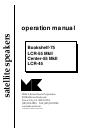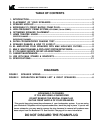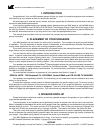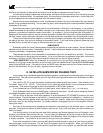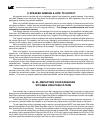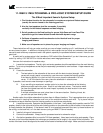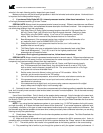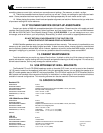
Bookshelf-75/Center-75/LCR-75/LCR-55
page 5
You will note that the tweeter in your LCR-55MkII and Center-55MkII speakers is mounted at a slight angle (4.7
degrees). This mounting is an integral part of the High-Frequency Prism System.
When the speakers are mounted properly, the tweeter will be angled away from the listening position. That
means that the surround channel speakers should be mounted with the tweeter angled towards the back wall of the
room (when the speakers are mounted on the side walls), and with the tweeter angled toward the closest side wall
(when the speakers are mounted on the back wall of the room).
When the speaker is mounted in this fashion, its stereo imaging and coverage of sound are optimized for a very
wide listening window that extends from the on-axis position towards the center of the room. If the speaker is mounted
with the tweeter pointed in the other direction, its sound quality will be adversely affected.
6. OPTIMIZING SPEAKER PLACEMENT
The sound quality produced by your speakers can be significantly enhanced by careful attention to their
placement. While we understand that you may not redesign your room to accommodate your speakers, coming as
close as possible to the ideal placement will give you much better sound.
The left and right channel speakers can be oriented either horizontally or vertically. The Center channel speaker
is designed for horizontal orientation (tweeter and woofer drivers next to each other), and can be angled (vertically)
towards your listening position.
Three factors are important in getting the best sound. They are:
A. Height (or angle).
B. Location away from room walls or reflecting surfaces.
C. Separation between Left and Right speakers.
A. HEIGHT (OR ANGLE)
Your M&K Speakers will always deliver sound superior to conventional speakers, regardless of where you locate
them. However, because they are designed for very fast and accurate transient response, they achieve even better
sound quality, and the flattest frequency response when properly oriented relative to your ear.
Ideally, the tweeters should be at the same height from the floor as your ears, when you are sitting in your main
listening position.
If you have the speakers mounted above or below this height, they sound their best when you angle the speakers
so that the tweeters are aimed at your ears when you are in the main listening position.
If you have a helper move the speakers while you sit and listen, you should be able to hear the difference when
the speakers are in the best location by listening for the brightest high frequencies and for the best "focus" of sound,
where you hear the sharpest sonic imaging of voices and instruments.
B. LOCATION AWAY FROM REFLECTING SURFACES
Your Speakers should be located, whenever practical, away from walls, the floor, furniture, or any other reflecting
surfaces. Do the best you can. Objects close to the speaker will reflect sound, and this reflected sound arrives at your
ear slightly later than the direct sound, which blurs sonic imaging and makes transients seem muted.
The delay is very slight, so instead of hearing an echo, you hear a "blurred" sound with less clarity that is not as
sharp and distinct as it should be. This time delay also affects frequency response and sonic imaging.
If the speakers are on a television set or shelves, locate them on the front edge, so there is no flat surface directly
in front of them. If the speakers will sit close to walls or other large objects, leave as much space as possible between
the speaker and the object. Ideally, your Speakers will be several feet from the nearest surface, but in most rooms
compromise is necessary.
C. SEPARATION BETWEEN LEFT AND RIGHT SPEAKERS
Here is a formula for achieving the ideal left to right stereo imaging. Think of a triangle formed by the locations
of the Left and Right speakers and your listening position. Ideally, the subtended angle formed should be between
45 and 50 degrees. Roughly, this means that the Left and Right speakers should be separated by about the same
distance that you are sitting back from the speakers. In other words, if the distance from your listening position to the
point directly between the speakers is 10 feet, place the speakers so their centers are 10 feet apart. See Figure 2 on
page 6.
Bookshelf-75/LCR-55MkII/Center-55MkII/LCR-45



